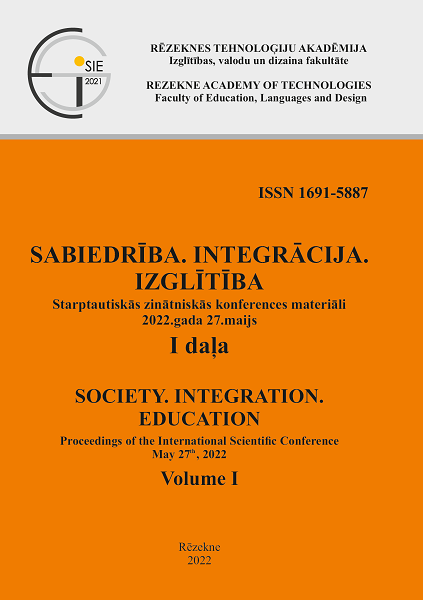PARAMETERS IN FORMULATIONS AND SOLUTIONS OF INTRODUCTORY PROBABILITY PROBLEMS
DOI:
https://doi.org/10.17770/sie2022vol1.6818Keywords:
combinatorics, higher education, probability theory, problems with parameters, school educationAbstract
Mathematical problems with parameters offer a higher semiotic complexity level of mathematical activities. The topicality of the research is determined by the fact that there are no studies on types of parameters in formulations and solutions of probability problems. The study aims are to analyse the current literature and propose an approach to classify parameters depending on their nature. Methodology - qualitative content analysis of probability problems from published textbooks and research papers. The main result - a parameter classification and interpretation scheme for introductory probability problems. The proposed parameter classification can help differentiate and individualise the study of probability theory and statistics.References
Aigner, M. (2007). Discrete Mathematics. American Mathematical Society, Providence.
Anderson, J. A. (2004). Discrete Mathematics with Combinatorics. With the assistance of J. Lewis, O.D. Saylor, 2nd ed., Upper Saddle River: Pearson.
Andreescu, T., & Feng, Z. (2004). A Path to Combinatorics for Undergraduates. Boston: Birkhauser.
Bardini, C., Radford, L., & Sabena, C. (2005). Struggling with variables, parameters, and indeterminate objects or how to go insane in mathematics. Retrieved from https://www.emis.de/proceedings/PME29/PME29RRPapers/PME29Vol2BardiniEtAl.pdf
Burgos, M., Batanero, C., & Godino, J.D. (2022). Algebraization Levels in the Study of Probability. Retrieved from
https://www.researchgate.net/publication/357371988_Algebraization_Levels_in_the_Study_of_Probability
Chow, T.C.F. (2011). Students' difficulties, conceptions and attitudes towards learning algebra: an intervention study to improve teaching and learning. Doctoral dissertation, Curtin University, Science and Mathematics Education Centre. Retrieved from https://core.ac.uk/download/pdf/195632071.pdf
Conroy, M.M. (2018). A Collection of Dice Problems. Retrieved from https://www2.karlin.mff.cuni.cz/~nagy/NMSA202/dice1.pdf
Drijvers, P. (2003). Learning Algebra in a Computer Algebra Environment: Design Research on the Understanding of the Concept of Parameter. Ph.D. Dissertation, University of Utrecht, Utrecht, The Netherlands. Retrieved from https://dspace.library.uu.nl/bitstream/handle/1874/886/full.pdf
Furinghetti, F., & Paola, D. (1994). Parameters, unknowns and variables: a little difference? In J.P. da Ponte & J.F. Matos (Eds.), Proceedings of the 20th Conference of the International Group for the Psychology of Mathematics Education, Vol 2 (pp. 368-375). Lisbon: Departamento de Educacao, Faculdade de Ciencias da Universidade de Lisboa.
Godino, J.D., Neto, T., Wilhelmi, M., Ake, L., & Etchegaray, S. (2015). Algebraic reasoning levels in primary and secondary education. CERME 9 - Ninth Congress of the European Society for Research in Mathematics Education, Charles University in Prague, Faculty of Education; 426-432. Retrieved from https://hal.archives-ouvertes.fr/hal-01286917/document
Gusak, A.A., & Brichikova, E.A. (2002). Teorija verojatnostei. Minsk: TetraSistems.
Heck, A. (2001). Variables in Computer Algebra, Mathematics, and Science. International Journal of Computer Algebra in Mathematics Education, 8, 195-221. Retrieved from https://staff.fnwi.uva.nl/a.j.p.heck/research/art/variables.pdf
Krastina, E., Sondore, A., & Drelinga, E. (2015). How to Promote Text Comprehension with Pupils of Grades 1–6 when Teaching to Solve Combinatorial Problems. Acta Paedagogica Vilnensia, 35, 67-80.
Krikis, D., Zarins, P., & Ziobrovskis, V. (1996). Diferencēti uzdevumi matemātikā. Rīga: Zvaigzne ABC.
Latvijas loto. (2022). Pieejams: https://www.latloto.lv/lv/latloto/
Meshalkin, L.D. (1973). Collection of problems in probability theory. Leyden: Noordhoff international publishing. Pieejams: https://www.gwern.net/docs/statistics/1973-meshalkin-collectionofproblemsinprobabilitytheory.pdf
Ross, S. (2010). A first course in probability. Eighth Edition Retrieved from http://julio.staff.ipb.ac.id/files/2015/02/Ross_8th_ed_English.pdf
Roussas, G. (2007). Introduction to Probability. Burlington Academic Press.
Sas, W. (2021). Dice Probability Calculator. Retrieved from https://www.omnicalculator.com/statistics/dice
Sedivy, J. (1976). A Note on the Role of Parameters in Mathematics Teaching. Educational Studies in Mathematics, 7(1/2), 121-126.
Smotrovs, J. (2004). Varbūtību teorija un matemātiskā statistika. Rīga: Zvaigzne ABC.
Sondore, A., & Daugulis, P. (2018). Combinatorics Problems with Parameters. 18th International Conference "Teaching Mathematics: Retrospective and Perspectives", Proceedings, 51-59.
Sondore, A., & Krastiņa, E. (2018). The Comprehension of Elements of Combinatorics in Real-Life Situations for Primary School Students. In P.Blaszczyk, B.Pieronkiewicz (Eds.) Mathematical Transgressions 2015 (pp.205-219).Towarzystwo Autorow i Wydawcow Prac Naukowych universitas, Kracow.
Steiners, K. (2001). Algebra 10-11. klasei. 6.daļa. Rīga: Zvaigzne ABC.
Uzdevumi.lv (2022). Mācību vadības platforma. Pieejams: https://www.uzdevumi.lv/p/matematika/11-klase/kombinatorikas-elementi-2162






